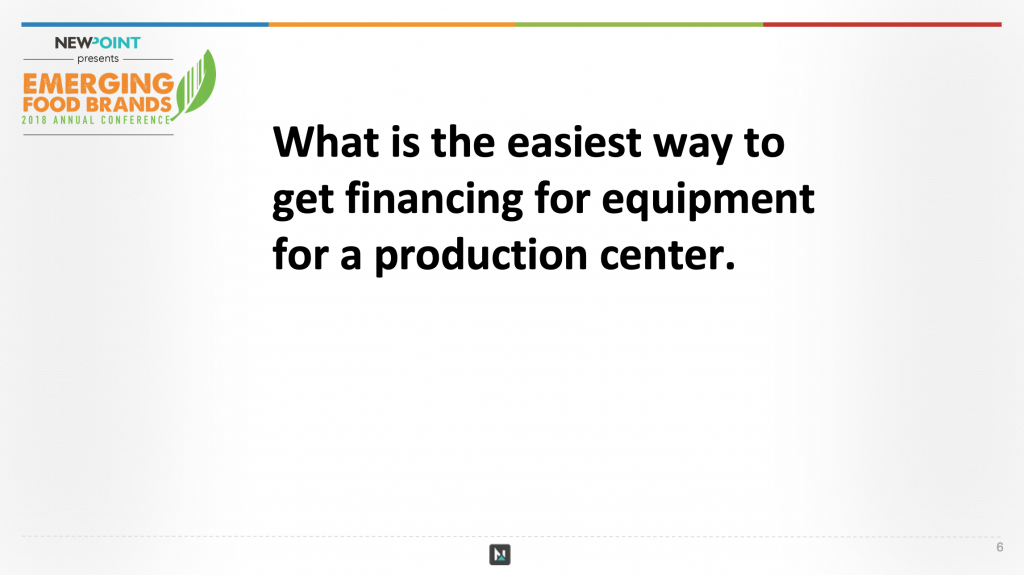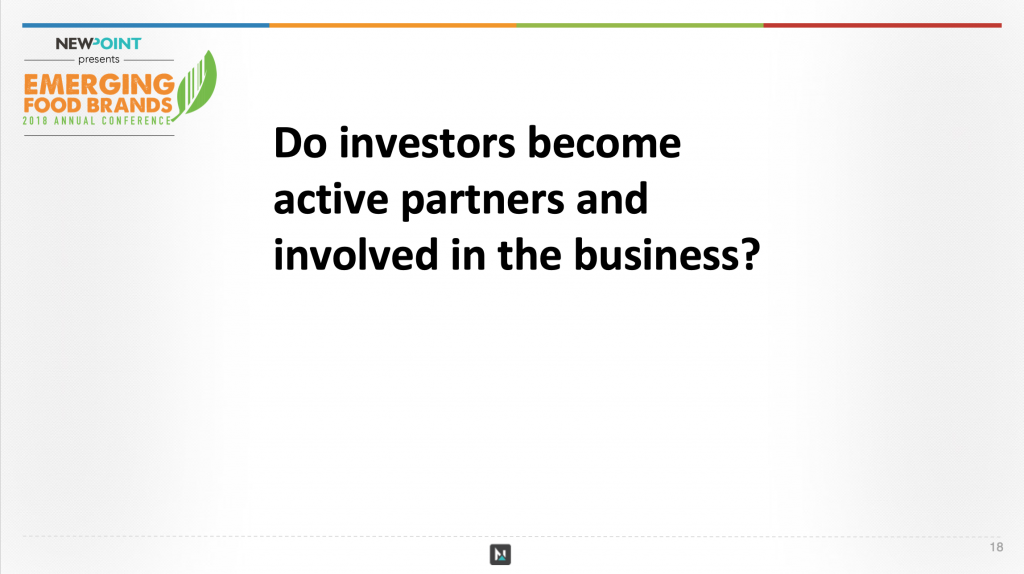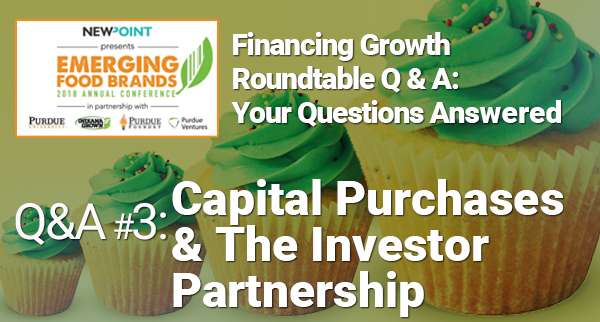Dec 18, 2018
Financing for Growth Roundtable Q&A #3: Capital Purchases & The Investor Partnership
Your Questions Answered: Q&A 1st Round of the Financing for Growth Roundtable #3: Capital Purchases & The Investor Partnership
Welcome to the 3rd in our series on the Financing for Growth Panel from our NewPoint Emerging Food Brands Conference. A short reminder of how this works:
Emerging Food Brands looking to grow have limited options financially. Many we talk to are self-funded through sales. This can be hard when they need come up with the capital to buy raw materials, packaging or labels to convert into final product when they need to fill orders. The more the sales, the better the opportunity is to have the cash for the next order with a little left over for profit.
This got me thinking. I’m a small business owner, and I tend to operate with a “buy-it-only-if-you-can-afford-it” mentality. But I also have a line of credit and a good relationship with my bank in case I need to invest in new equipment, staffing or training to service new business. But what happens if I am growing faster than my traditional financing relationships can help?
This series explores the finance options emerging food brand have if they want to grow.
Questions about financing? The content of this Financing for Growth Panel portion (and all program content at our conference) was submitted as questions during registration by the 64 food company/brand attendees. Our expert presenters then addressed the questions—and more—in their programs. In the coming weeks, we’ll be posting each presentation to the “Intel” section of our website. So check back often!
Getting reacquainted with our expert panel:
John Hanak (Moderator): Managing Director of Purdue Ventures. John is the Managing Director of Purdue Ventures and also an Entrepreneur in Residence at the Purdue Foundry.
Andrew Bluestein, Co-Founder & Managing Partner, Bluestein & Associates. Andrew is the co-founder and Managing Partner of B&A, which includes developing the firm’s investment strategy, leading the investment committee, and advising portfolio companies.
Andy Miller, Managing Director, Ouabache Investments. Andy leads the Ouabache team bringing prior experience as Corporate Development Leader at Weaver Popcorn where he focused on sourcing and evaluating more substantial bolt-on opportunities.
Jacob Schpok, Entrepreneur-in-Residence (EIR), Elevate Ventures. Elevate EIRs provide first-time entrepreneurs with business advisory services to help them navigate the uncharted waters of starting a business, from launch to exit and every decision in between.
We have some excellent topics so let’s dive in…

Financing Production Equipment
John Hanak, moderator: Let’s go to the next question. Andy, I don’t know if this is in your sweet spot, but what’s the easiest way to get financing for equipment for a production center?
Andy Miller: Well if it’s equipment, a traditional bank loan may be something you want to consider. If it’s something that’s relatively unique or new, you can also use equity financing to do that. I don’t think there’s a one size fits all, as it relates to this. Again, I would probably start with, “Can I get a bank to look at the collateral of the equipment?” and finance it that way versus giving up equity in your company. Again, when you’re giving up equity, it should probably be for things that a traditional bank investor, or another traditional investor, wouldn’t do as collateral. Production equipment is something that most banks can wrap their minds around and say, “Okay, that asset has value, I can lend against that.”
John Hanak, moderator: Any other comments on there?
Andrew Bluestein: Yeah, When there’s a hard asset involved here, think about whether there’s non-equity financing. We’re investors in a coffee company up in Minneapolis, and they were moving and creating their production center and buying equipment. There’s a state program in the state of Minnesota, and there may be programs here in Indiana you should look at, where they were able to get a 0% interest loan from the state to finance a portion of the equipment. There’s a personal guarantee around it which scared the entrepreneur, but it was a way for them to get financing. Also, there are equipment financing companies out there who can either give you a loan against the equipment or sometimes they’ll buy the equipment and then lease it to you. Think of that like a car or a house, when there’s actual collateral against it, there could be other ways, outside of equity financing.
Andy Miller: Just one other thing on production equipment, I would strongly encourage you, particularly in the early parts of your company, to try to use as much co-packing and co-manufacturing as you can. Once you start buying equipment, you are defining a lot of what you’re going to do, which is not a bad thing. It goes back to the concept of readiness. Know when it’s time for you to build a plan and start buying your manufacturing equipment. I will tell you that Weaver Popcorn, which is a 300 million dollar company, we still do co-manufacturing on some of our earlier stage stuff, so don’t be afraid, you’re going to pay a little bit of a premium, but the flexibility that brings is tremendous.
At this point, the Financing for Growth Roundtable ended and moved to an open Q&A Workshop.
Question: Do investors become active partners and involved in the business? 
Jacob Schpok: First of all, they’re partners from day one if they put money in. I know what you mean, though, is are they more hands on. Do they take a position where they’re dedicating real hours week to week towards the business? Generally, no.
Generally, when you’re looking at institutions investors, it’s their job to find opportunities to get a higher return on investment or the limited partners that are better entrusting them with their financial resources. That being said, though, there’s a fair number of business angels or folks that may not directly identify themselves as a business angel, just someone with a high net worth, whose looking for something to get involved in and would consider taking a leadership position in a company.
The other side of that equation, though, that you have to be careful about is you’re indeed entering into a marriage with every investor that you get. So it needs to be a symbiotic relationship on what they’re obtaining for the money that they’re putting in the company. So there’s plenty of horror stories out there about the smallest investor sometimes becomes the squeakiest wheel. Because they put in money that, frankly, they shouldn’t have put in in the first place. So they want to see their exit as quickly as possible.
Where on the other side are those that might be retired from a successful career and they still have quite a bit of energy left in them and they want to get involved in another project? So that does exist. It’s been my experience that when interviewing entrepreneurs, the industry agnostic between entrepreneurs, just any of that that are seeing a degree of success in their business and you ask them, what percentage of their success is directly tied towards relationships and connections that they’re making.
I’ve never heard the answer be less than 50%. More often than not they either say all of it, or it’s somewhere between 80 to 100. It’s so personal when it comes towards raising capital or to the extent of finding distributors, or those early sales, I’m going to call them sales channels, or sales partners. It’s people that are being the early adopters and believers of other people. Strip the business and the brand aside.
So, with that being said, if you’re looking for an investor who also is going to be hands-on, I can all but assure you that that person you’re going to find is going they are going to come with personal recommendations. These are people they trust.
Andrew Bluestein: I’d say I think it varies based on the investor. So we typically are investing on fairly early stage companies, and our background as consultants, we like to get involved, and with some companies, we get more involved with others, but the way that we try to help them one area is just thinking about their strategy and their strategic plan. So we will go in there. We try to share what we’ve learned in diligence. Also, have a conversation about the market opportunity and how you’re trying to win in the market, how do you build the organization, and try to align with the entrepreneur on what their strategic plan is. We try to put some of our structured thinking around those elements. And then, part of doing that is we identify where we see opportunities to help them potentially.
Here’s a story that illustrates how this works We invested in a Tampa company that makes grain-free baked goods. They’re in a bunch of stores down there. They’re up to like four thousand stores, doing awesome. We love the company. But we talked to them about the brand, and how do we build a brand around this. What is the brand mean? What is the real mission of what we’re trying to do in the marketplace? They’ve been so focused on execution, they have a story, but they’re not exactly sure what it is. They don’t have marketing backgrounds, so they don’t know how to get there.
So we said, “This is an important key area. Now, is the time to start thinking about this.” We shared some of our ideas. I’m not the best marketer, but I’m an okay marketer. And we gave them some inspiration, but we also said, “You need to hire someone head of marketing.” You need someone, and we introduced them to some people we know who could be consultants on a short-term basis. We thought that could work. That isn’t working, but there’s nothing in the full time.
From there, we say, hey, do we know anyone who could be a fit? It’s in Tampa, and we don’t know as many people in Tampa. But they needed to hire a head of sales as well, and we asked someone in our network and said, “Hey, you know anyone?” And someone in our network said, “I know this guy in Tampa. He’s a terrific guy. He’s looking for that position. Will you make the connection?” We’ll see if they hire him, but we try or be helpful, and each investor is going to be a little bit different, particularly on the early side when you’re talking, and you use this term angel investor. They’re any individuals who maybe aren’t from an investment firm, they understand, they want to help.
And so part of that is thinking, “How can I get help from my investors?” Always, when you do an investor update, and one of the things when you start taking on outside investors you should think about doing is, doing some either monthly or regular updates and at the bottom, it should only say, “Hey, here’s an ask. I’m looking for new distributors. Does anyone know anyone? Any good PR people?” Those are the things where then your investors maybe they can help, perhaps they won’t, but at least gives them a chance to try to help.
Andy Miller: The other thing I’d say is making sure before you sign the deal, you have a healthy dialogue about governance and what roles and responsibilities are going to be. We make it abundantly clear we’re not going to be passive. If you don’t want our help, you don’t want to see us on your doorstep, not necessarily on a regular basis, but bringing help and consistency, then we’re not your right partner. So I think having that dialogue and even going as far as when you get into the legal documentation having governance clearly outlined of who’s going to make the decisions, what role does the board play, what role does the owner play. You can head off a lot of awkward moments if you have that dialogue before you close the deal.
The Financing Growth Panel continues in our next post: Financing for Growth Roundtable Q&A #4: Market Potential & Investment Sizes
We Need to Say this…
I’m going to keep hammering this caveot…just like in our first two workshop Q&A series (Social Media Marketing and Vetting a Co-Packer):
- Every brand and company is different: The experts here are addressing general questions from a wide variety of companies. Use their advice and guidelines as a starting point.
- This post is by no means all you need to know: There are a ton of great resources to draw advice on when considering a financing growth. The above are a few questions that food attendees asked for this finance and investing workshop. Here are a few more awesome references for more intel:
For those of you with more questions about investing, finance or want to discuss something in this post, I’d love to hear from you. Contact me at patrick@newpointmarketing.com.
And, as always, Keep Moving Your Brand Up the Food Chain!

Patrick Nycz
Founding President






